As part of Berkeley Lab’s Community-Centered Solar Development (CCSD) project, this research set out to explore deep insights and perceptions from large-scale solar (LSS) stakeholders that only qualitative data can provide to identify key factors driving project success or threatened failure. Case studies, such as those utilized in this research, are uniquely adept at capturing the subjective experience of individuals and at identifying variables, structures, and interactions between stakeholders. Our case studies included 54 semi-structured interviews across 7 different LSS sites, representing a diversity of geographies, project sizes (MW), site types (i.e., greenfield, agrivoltaic, and brownfield / contaminated sites), zoning jurisdiction types, and more. In addition to local residents living in close proximity to these LSS sites, we interviewed other key stakeholders involved in the projects such as developers, decision-makers, utility representatives, landowners, and individuals from community-based organizations. The overarching aim of this case study research was two-fold: (1) to inform subsequent tasks in the CCSD research project (including an upcoming national survey of LSS neighbors), and (2) to provide insights into the following set of research questions: -What are the key positive and negative drivers leading to support and opposition to LSS projects? -To what extent do LSS projects exacerbate or mitigate perceived inequities and marginalization within hosting communities and how can those inequities be mitigated going forward? -What strategies can communities employ to align LSS development with local land-use plans and community needs and values?
Tag Archive for: AgriSolar
In this study, researchers tested hypotheses on the extent to which varying image content representing different types of grassland use affects the visual perception and acceptance of agrivoltaics. In the before-and-after comparison, the acceptance of agrivoltaics increased significantly only for grasslands and special crops. The results suggest that attitudes towards agrivoltaics are rather stable and cannot be easily modulated by additional information.
By Allen Puckett, NCAT Technical Writer
July 2023
The Solar Shepherd provides grazing services in Brookfield, Massachusetts, with 75 sheep that graze a solar array site owned by SWEB Development, a European clean energy firm. This beneficial partnership was born when SWEB reached out to Solar Shepherd for grazing services after seeing their solar-grazing sites on social media. Learn more about the partnership in the AgriSolar Clearinghouse’s video How a Shepherd and Solar Developer are Joining Forces to Grow Sheep, Clean Energy.
Solar Shepherd’s founder and owner Dan Finnegan is a third- generation sheep farmer in eastern Massachusetts. His history working in a corporate environment led him to think more about what was important to him—the land, local farming, and clean energy. While he likes raising sheep, there wasn’t enough acreage for it to be profitable without agrisolar sites.
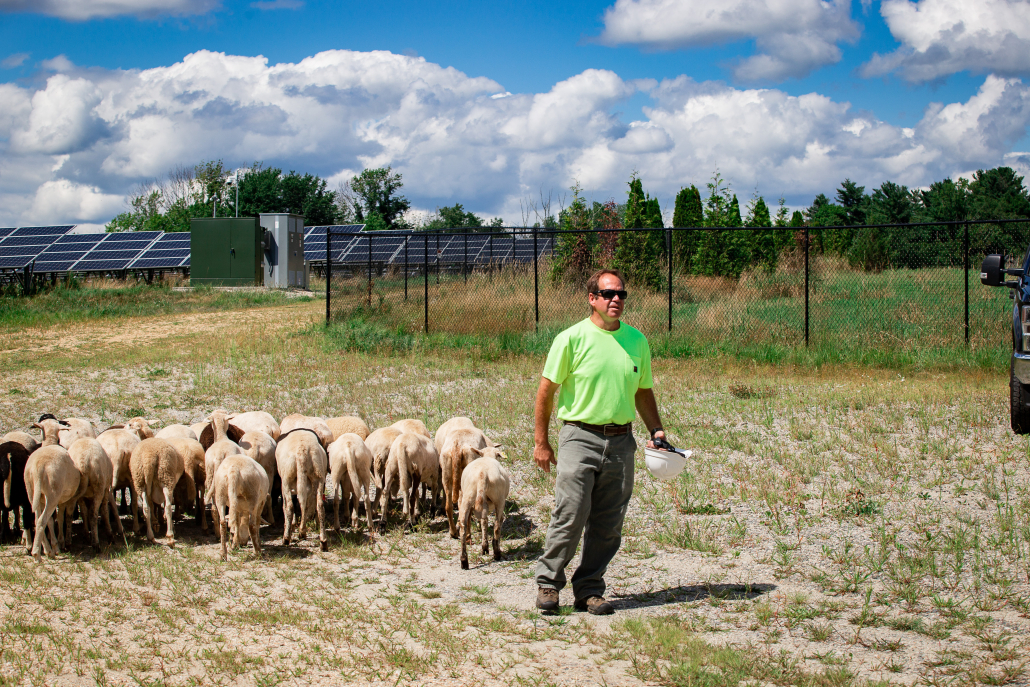
“It wouldn’t be enough to produce a living for a family,” he said. “This is more than a hobby-farming operation. With solar grazing, we dramatically expand our flock. We work hard to be competitive with landscapers on these sites. The grazing fees mitigate the costs and pay down the investment to take the show on the road (transporting sheep to solar sites). We’re used to farming out the back door, and now we have sites spread hundreds of miles apart. The grazing fees make that cost affordable.”
“I saw a solar array built on a lambing pasture, and a landscaper showed up with a tractor and started mowing up the solar arrays. He was going about 30 mph with a batwing sprayer and was mowing the rows and hosing down the panels around the arrays. I was thinking, they should just put the sheep down there and let them graze,” Dan recalled.
Solar Grazing Site Specifications and Management
The site is in a 15-acre array that produces 5 MW of DC and 3.375 MW of AC, enough to power approximately 1,100 homes. A landowner leases the land to SWEB, and SWEB hires Dan to graze the solar arrays with the sheep. The pricing is relatively the same as traditional mowing and gas-powered landscapers, but grazing sheep comes with many environmental benefits, such as enhanced landscape stabilization that directly benefits the solar companies. This stabilization includes deeper root systems on previously rocky terrain, improved turf health, and significant runoff reduction.
Solar Shepherd practices rotational grazing on their sites, which allows more carbon in the soil and retains more moisture. “We see that impact very rapidly. There are some sites we had that, in just one year, the customer came to us and said, ‘I can’t believe the impact the sheep had on the vegetation sustainability. It was rocky before, and now there are deeper root systems, stabilized soil.’ Erosion is a big concern at the base of the panels. A direct benefit to the solar companies is stabilizing that ground,” Dan added.
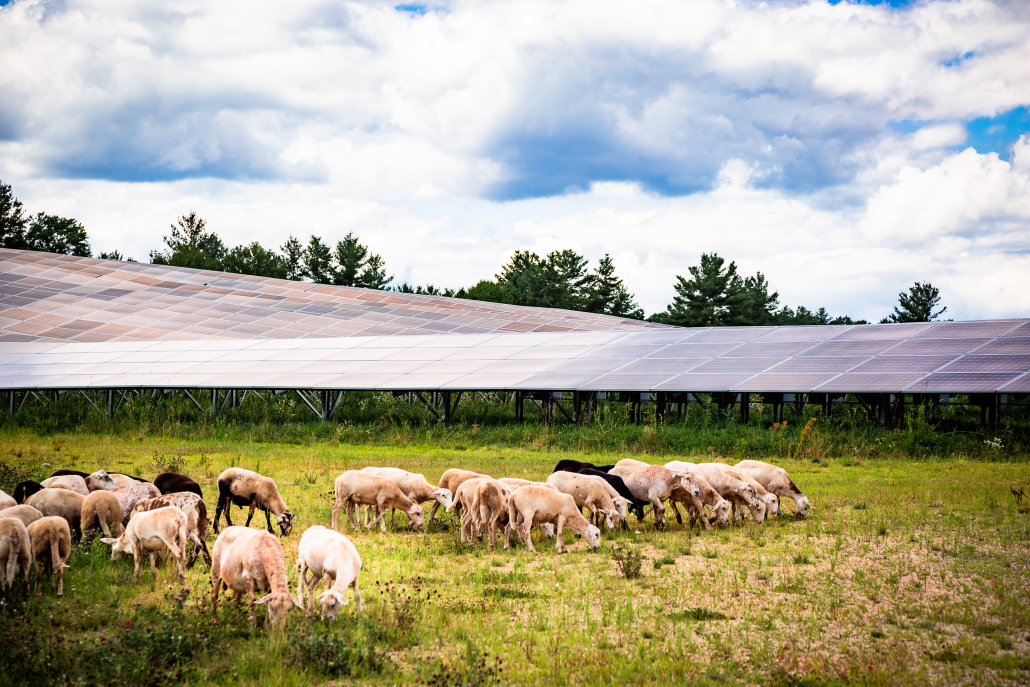
There’s also the “Fuzz and Buzz” – a solar seed blend used at the Brookfield site that benefits pollinators and sheep. It’s not as robust of a floral bloom, but the bees and sheep benefit greatly from this blend. A gas-powered mower removes all the vegetation on an array in a single day. The sheep take around a month to “mow” the same array. This allows valuable pollinator habitat to be left for the bees and birds. There’s good seed-to-solar contact, and the imprints from the sheep hooves allow the seeds to be captured in the soil. The sheep help the effectiveness of reseeding a site and some graziers will run the sheep back over the seeds to help stomp them down into the earth.
Solar grazing includes running three main operations: a sheep farm, a trucking company (as you move the animals), and a commercial landscaping business. “It’s more than just opening the gate, throwing the sheep in there, and driving away. There are always some sites that require things outside the lines,” said Dan.
Dan’s partner, border collie Reggie, has been vitally important in effectively managing the sheep on solar sites. In the trucking operation, sheep are loaded in and out of trucks over and over, and that requires collecting them from one site to another to be loaded into the trucks.
Reggie is immensely valuable in this process. She rounds up the sheep quickly, whereas it would take multiple human workers significantly more time. She is vital to effective time management (and cost, if you consider paying multiple workers to round up sheep all the time). Reggie moves the sheep around the array in accordance with rotational grazing practices.
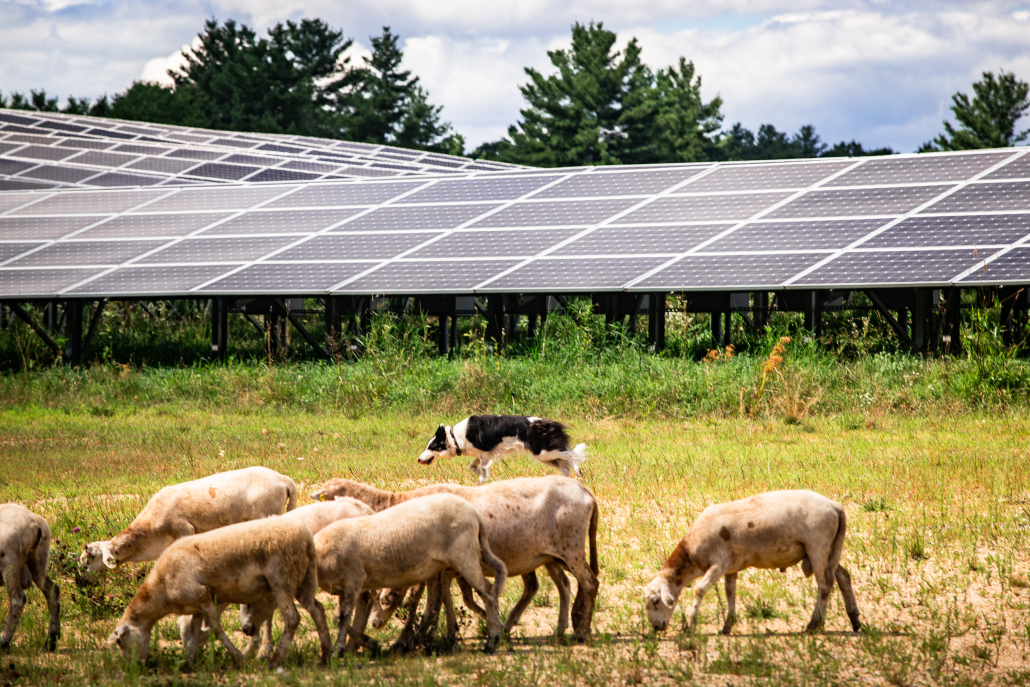
Grant Incentives in Massachusetts
Massachusetts does have a grant program for dual use of solar (Massachusetts SMART Initiative), but it is “written in such a fashion that it can be difficult to be profitable,” said Dan. The grant does not apply to sites that already exist, and it requires panels to be built 10 feet off the ground. Solar Shepherd has not received this grant and has also not yet grazed an array that fits the 10-foot grant requirement.
Livestock production is diminishing in Massachusetts and what’s left is small-scale vegetable farming. Dan speculates that the state is writing laws for solar development incentives with this in mind instead of grazing sheep under solar panels.
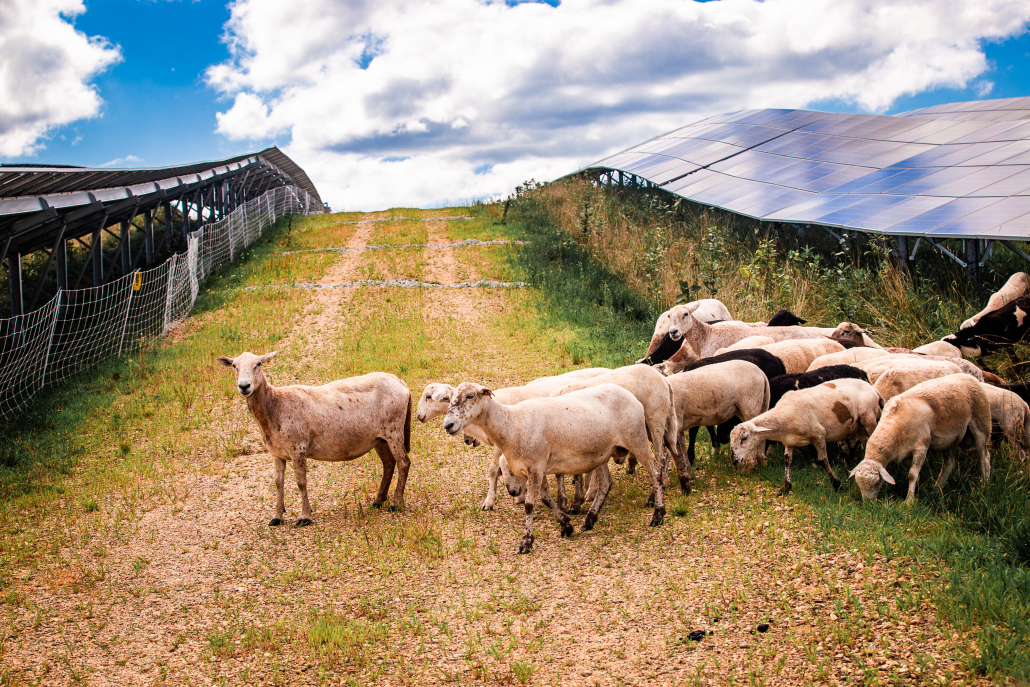
Community Response
“The community loves what we’re up to,” said Dan. “We had about 500 comments (on the recent video featured on CBS) and all of them were loving what we are doing. There are a few political comments. So, grazing sheep on solar might bring some unification from a political perspective.”
He also added that, “At least half the time I show up, there is a family there outside the gate at the fence watching the sheep. People are wanting to bring kids out to the sites to see the sheep. I’d like to do a program where people can come see them. We would love to host a solar event. We’re going to bring some sheep to town off the hill in Brookfield so people can see them and interact with them. I have a dream of bringing a bus load of kids out here to see how bees, sheep, and everything all come together.”
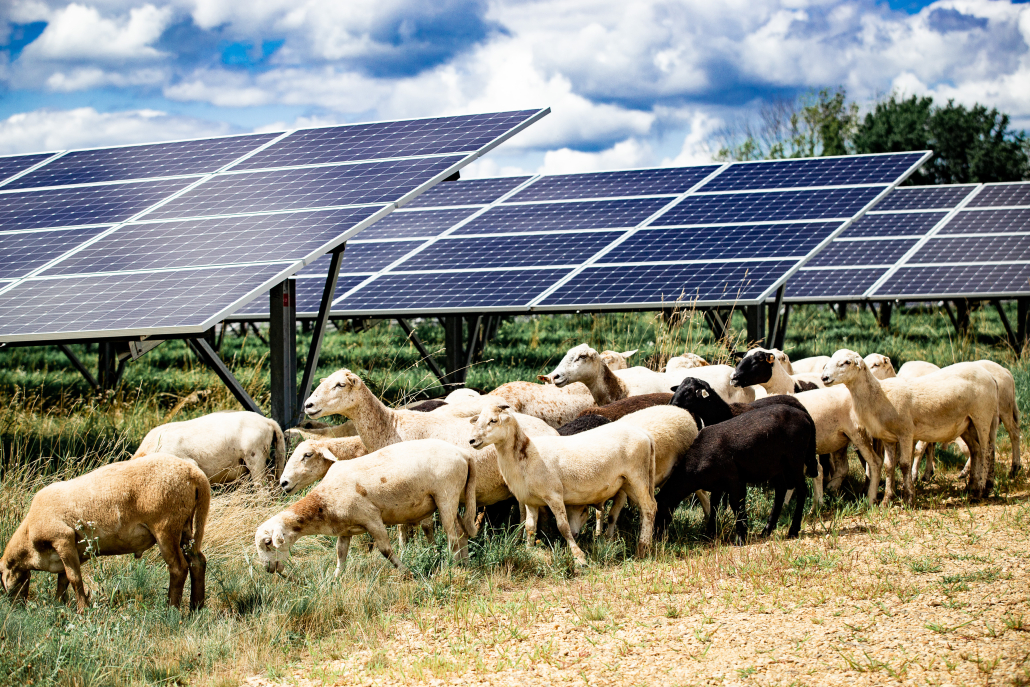
Since the Brookfield location is an ancient hay site where indigenous peoples managed the land when colonists first arrived, not damaging the vegetation or compacting the soil during the solar array installation was very important. This priority to minimize damage to the land could have a positive impact on community support for a solar site, particularly on ancient farmland or similarly valued sites. Communities like to see that a (solar) development company cares about the land and the process of development.
Considerations for New Sheep Graziers
New sheep graziers or those thinking about getting into sheep grazing on solar sites should consider a couple of things throughout the process. Educating themselves on what’s happening on the solar array is very important. “They don’t have to be engineers,” says Dan, “but they should understand what’s happening and what the potential dangers are and keep themselves and animals away from those areas. Stay out of areas where you might think ‘I should have an electrician in there.’ These are areas that contain things like cable trays and equipment pads.”
Don’t move forward with grazing a solar site if you haven’t walked the location and examined it for suitable conditions for your sheep. If construction techniques did not leave a space where you would feel comfortable leaving the sheep, such as poor wire management or dangerous or sharp edges on array components, it may be a good decision to decline grazing in that location. Dan says the sites he turns down are for animal welfare reasons. There might not be enough nutrition on the site, but it is usually wiring management. A good perimeter fence can also make a site more ideal for sheep.
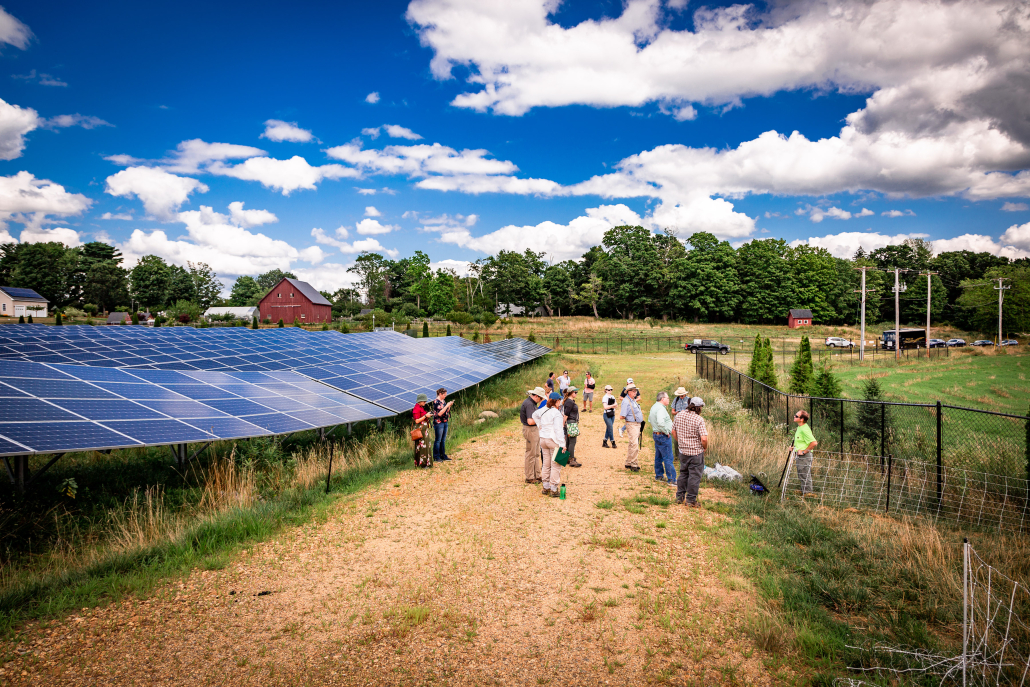
Operating a grazing operation on your own property requires having a plan for food and water delivery, as well as for avoiding predation. A plan should be in place for responding to issues that may arise on the site and with little notice. Solar Shepherd has a 24-7 hotline for such issues.
For fencing, Dan prefers to use electric netting, which provides effective protection from predators. Coyotes prefer to go under the fence rather than over it, and considering such nuances in predator-prevention strategies can help design a fencing system that is most effective for your area and your circumstances. Hiring people who think from the sheep’s perspective is important, says Dan. Fortunately, he has not had any issues with predation to his sheep.
The Future of Solar Shepherd and Solar Grazing
The future of Solar Shepherd is looking bright. It originally took the company approximately one year to get hooves on the ground at a solar site. Now it only takes about a week or two. “I feel great about the solar grazing future and Solar Shepherd. The sales pitches are getting shorter and shorter. The world is becoming aware of this subject. Five years ago, it was, ‘You’re doing what?!’ The last pitch I gave was an hour-long presentation. I got 15 minutes into the meeting, and people said, ‘It’s great; we are ready to sign.’”
Written for the AgriSolar Clearinghouse by Sarah Bendok, Growing Green
I am a rising sophomore at Phoenix Country Day School. Since I was young, I have always loved gardening. Every summer, I visit my grandma’s village and work in her garden leisurely while observing other farmers in the community tirelessly performing back-breaking labor just to put food on the table. This love for gardening continued while the images of these farmers more vividly resonated in my memory. As I grew older, I started volunteering at community gardens in Arizona, such as Spaces of Opportunity, a 19-acre urban farm that promotes healthy food choices while allowing low-income individuals to grow and sell their produce. I also have volunteered with Tiger Mountain Foundation, an organization dedicated to giving jobs and empowering people in low-income communities through community gardens in South Phoenix. While volunteering, I saw how much effort and hard work these farmers put in just to take home meager earnings. At the same time, these farmers struggle with worsening environmental conditions and decreasing crop yields. Volunteering at community gardens made me realize there is a whole story behind where our food comes from, involving people making sacrifices to feed our population. I will never forget the smile on a farmer’s face when he harvested 10 pounds of pepper. What if I could improve his working conditions? What if I could decrease the number of resources he uses for agriculture so he can earn more profit? What if I could plant the seeds of a more equitable, sustainable agricultural system in South Phoenix?
Workers rely only on their crops for food and income at the community gardens where I have volunteered. Since they do not have the money for the same technologies that large-scale farms have, they depend on their natural resources to help them grow their crops through agroforestry and other natural practices. Instead of destroying the biodiversity to expand their farms, they integrate different trees, shrubs, and other plants to improve soil quality, reduce water use, and use them as natural pesticides to drive insects and other pests away. By integrating these natural tools, they could increase their crop yield. Working at these gardens and learning how they grow their crops, I became interested in how we can apply these concepts to all farms and expand the use of widespread and futuristic, sustainable technologies.
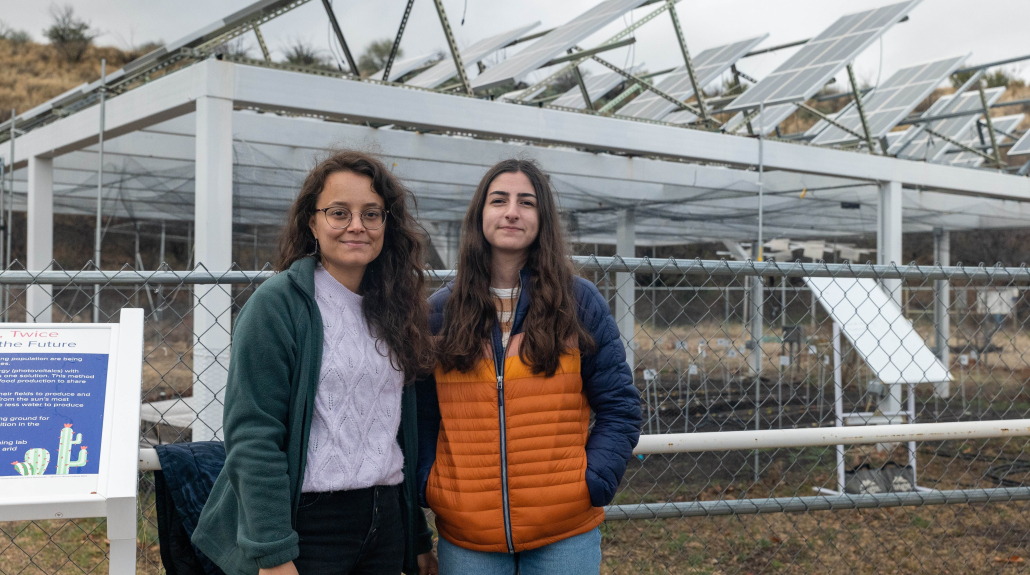
University of Arizona graduate student Nesrine Rouini (left) and Sarah Bendok at Biosphere 2’s agrivoltaic solar array. Photo: NCAT
This interest made me want to contribute to making agriculture more sustainable, especially at the community gardens where I have volunteered. So, I created a 501(c)(3) nonprofit called Growing Green to help fund and implement eco-friendly technologies at these farms. Our primary goal at Growing Green is to promote technologies at the intersection of agriculture and sustainability. One of the projects I have been working on through Growing Green is creating an agrivoltaics system at Spaces of Opportunity. I reached out to AgriSolar Clearinghouse, which allowed me to be in their peer-to-peer mentoring program by connecting me with Professor Greg Barron-Gafford and his team from the University of Arizona, Nesrine Rouini, and Alyssa Salazar. They have provided me with mentorship on the design of the agrivoltaics system and phenology data collection. In addition, they invited me to an agrivoltaics farm-to-table event at Biosphere 2, where I presented my project to the attendees and could sample dishes prepared with the vegetables grown under solar panels. The food was amazing, and the vegetables did not taste any different from the ones that are not grown with agrivoltaics. Separately, I have worked with Fundusol LLC, which has also helped me design the agrivoltaics system by entering the location of the system and crops to be planted into their proprietary algorithm to determine the optimal angle and spacing of the solar panels. Because of these mentorships, I have been able to teach everything I learned to farmers, solar developers, and others in my community about the benefits agrivoltaics and the significant and positive changes it could bring if implemented.
To build this 5-KW agrivoltaic system, I connected with FOREnergy and Titan Solar for the installation of the solar array. In June, we had the site surveyed and are in the process of submitting permits to the City of Phoenix. The anticipated cost of this project is $20,000, and I am working on getting donations to be able to finance this project through community events, presentations, grants, and my website.
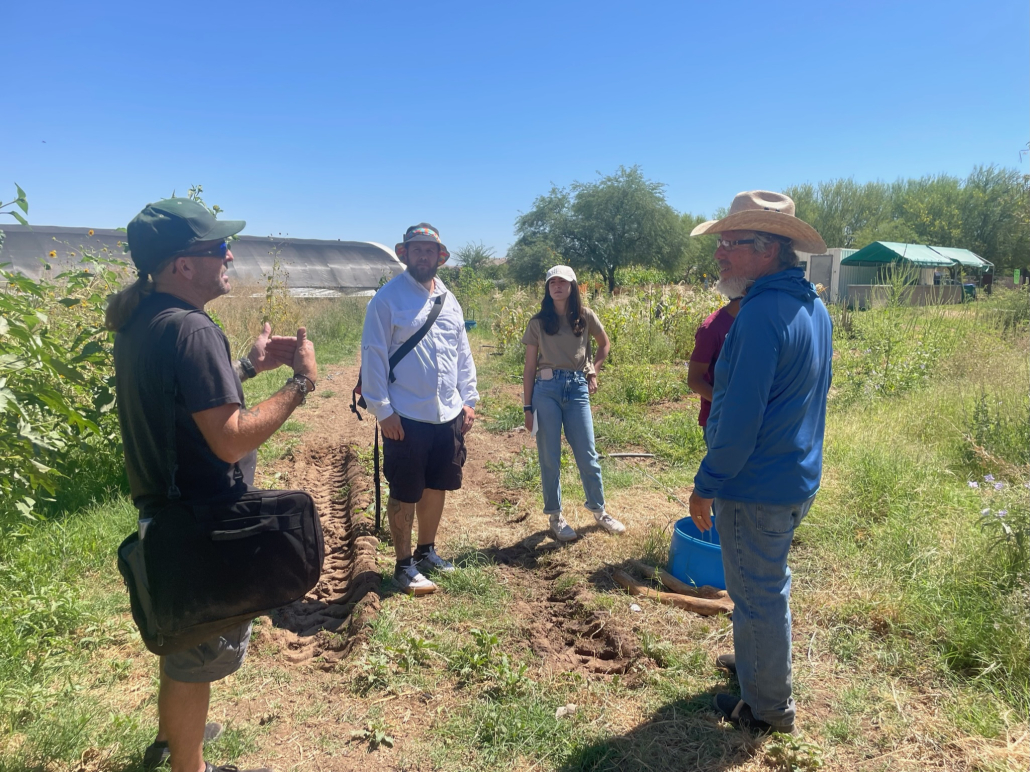
Site survey with members of Spaces of Opportunity, Titan Solar, and Sarah Bendok to map out the system. Photo: Growing Green
Separately, I was able to build a smaller agrivoltaics system over a raised garden bed at Spaces of Opportunity with donations from different local organizations to educate the community on the benefits of agrivoltaics while doing small-scale research. I have planted two types of cherry tomatoes and chiltepin peppers in this bed, but I plan to test crops native to Arizona in this location later on. I am also in the process of building another agrivoltaics raised garden bed at Garden of Tomorrow. There, I hope to plant a variety of crops that have not yet been tested with agrivoltaics to be able to continue to learn about which crops benefit from this technology. Although these beds are small-scale, I have started collecting data and educating the community on agrivoltaics by involving adult volunteers from the Desert Botanical Garden and employees from Tiger Mountain Foundation. I have connected with teachers from a low-income school near Spaces of Opportunity to engage students on these projects to help them learn more about sustainability within farming and renewable energy.
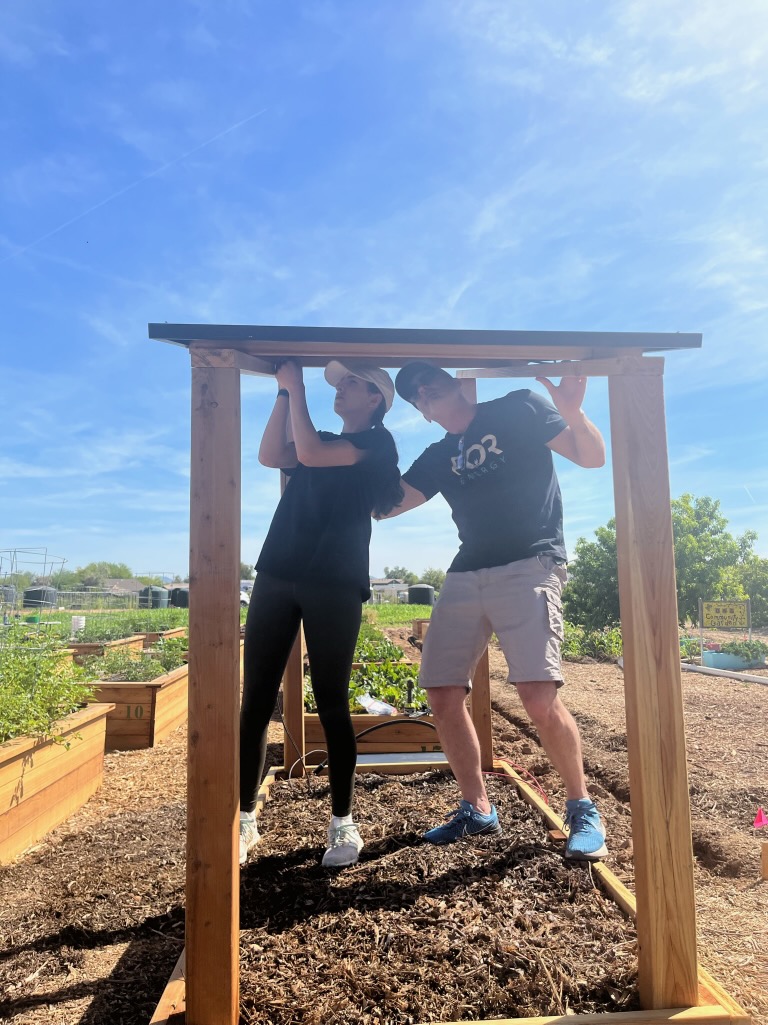
Dan Mullaney from FOREnergy and Sarah Bendok installing the garden bed solar panel at Spaces of Opportunity. Photo: Growing Green
Without the guidance and support of Stacie Peterson and Anna Adair from AgriSolar Clearinghouse, I would not have been able to come this far with my projects. I am very grateful for the opportunities and connections they have provided me with and hope to continue to promote agrivoltaics alongside them.
If you would like to support, partner with, or collaborate on this initiative, please email me at contactus@growing-green.org or visit our website.
Solar grazing is on the rise in the United States with dozens of new operations springing up across the country. However, with all of this growth in mind, an important question remains: if a grazier wants to enter the solar grazing market, how much will it cost, and how much revenue can they generate? Budget templates exist that can provide a grazier with guidelines, but hard data on grazier costs and revenues is more difficult to come by.
Researchers at the University of Illinois Urbana-Champaign’s Bock Agricultural Law & Policy Program set out to answer this question as a project through the National Renewable Energy Laboratory’s ASTRO InSPIRE Seed Grant Program. Undergraduate students Tyler Swanson and Quin Karhoff, supported by Post-Doctoral Researcher Jessica Guarino and Professor A. Bryan Endres, conducted a survey of American solar grazing practitioners to gather data on common capital and labor investments, as well as operation sizes and revenue streams. The researchers hope that the findings of the survey will help graziers interested in entering the solar grazing market better understand what costs and revenues they can expect and contribute to more accurate budget tools for potential solar graziers. The results of the survey are included in their fact sheet The Economics of Solar Grazing.
OCS Releases Guidance on Community Solar and LIHEAP for Grant Recipients
“The purpose of this grant recipient information is to: 1) confirm that LIHEAP funds can be used for solar energy use through new and existing electric payment mechanisms, such as community solar subscription fees; and 2) provide LIHEAP grant recipients with recommendations to consider when utilizing LIHEAP funds for community solar subscriptions.” – acf.hhs.gov
Benefits of community solar include cost savings, access to clean energy, support for local communities, and flexibility in subscription options.
Solar Grazing Benefits Sheep Herders with Revenue Opportunities
“The US solar industry has been growing rapidly: The country is expected to break solar construction records this year by adding more than 32 gigawatts of capacity, according to a Bloomberg NEF outlook. That’s enough to power more than 25 million homes. At the same time, there are concerns there won’t be enough cropland to feed a growing world population, especially if acreage is covered by buildings, roads or photovoltaic installations instead.
The American Solar Grazing Association, founded in 2018, estimates about 5,000 sheep are currently maintaining US solar sites. ‘The sheep do a better job supporting the biodiversity than a conventional mower,’ said Jay Smith, Director of Asset Management at Standard Solar. In some instances, sheep are better suited to maneuver around solar panels than conventional mowers and help reduce carbon emissions.
The practice [Agrisolar] is giving sheep herders a lifeline, introducing a new revenue stream after a decades-long decline for the US lamb industry. The number of sheep slaughtered in the US has been averaging over 2 million head in recent years, compared to more than 9 million in the early 1970s, according to Department of Agriculture data.” – Bloomberg.com
German Agrisolar Project Uses Solar to Benefit Hop Growth
“Germany’s Agri Energie has commissioned an agrivoltaic project in Hallertau, near Munich, in the German state of Bavaria. The €1.5 million ($1.64 million) project combines solar generation with hop growth.
The company installed the PV system on steel masts, providing protection to hop plants from sunlight and hail, while also reducing evaporation. In addition, the system serves as support for the hop plants.” – PV Magazine
Written for the AgriSolar Clearinghouse by Allison Jackson, Colorado Agrivoltaic Learning Center
The Boulder Housing Partners Triangle Solar Array is one of the first solar arrays in the Boulder, Colorado, area that is solely dedicated to offsetting energy use for low-income residents. The array is a south-facing fixed array with the leading edge of the solar panels about two feet off the ground. Construction was completed in 2021, and the array will generate over 19 GWh of solar energy in the next 10 years.
This solar array was built on 3.8 acres of degraded, rocky soils with prairie dog burrows and overgrown weeds. It was not an ideal spot for agrivoltaics (co-location of photovoltaics and agricultural activities), but that is what makes the possibility of rehabilitating solar land so appealing. Byron Kominek, owner of Jack’s Solar Garden and executive director of Colorado Agrivoltaic Learning Center, and Duncan Gilchrist of The Nature Conservancy had ideas about repurposing the land around these panels. “If we can demonstrate the ability to grow vegetation in a south-facing fixed solar array built on some of the worst terrain you can imagine for agricultural activities, then we will know that agrivoltaics can work within any solar array site,” stated Byron Kominek. According to Duncan Gilchrist, “The Nature Conservancy’s interest in this project is to demonstrate a replicable model for agroecological land restoration within solar arrays that weren’t originally designed for agrivoltaics.”
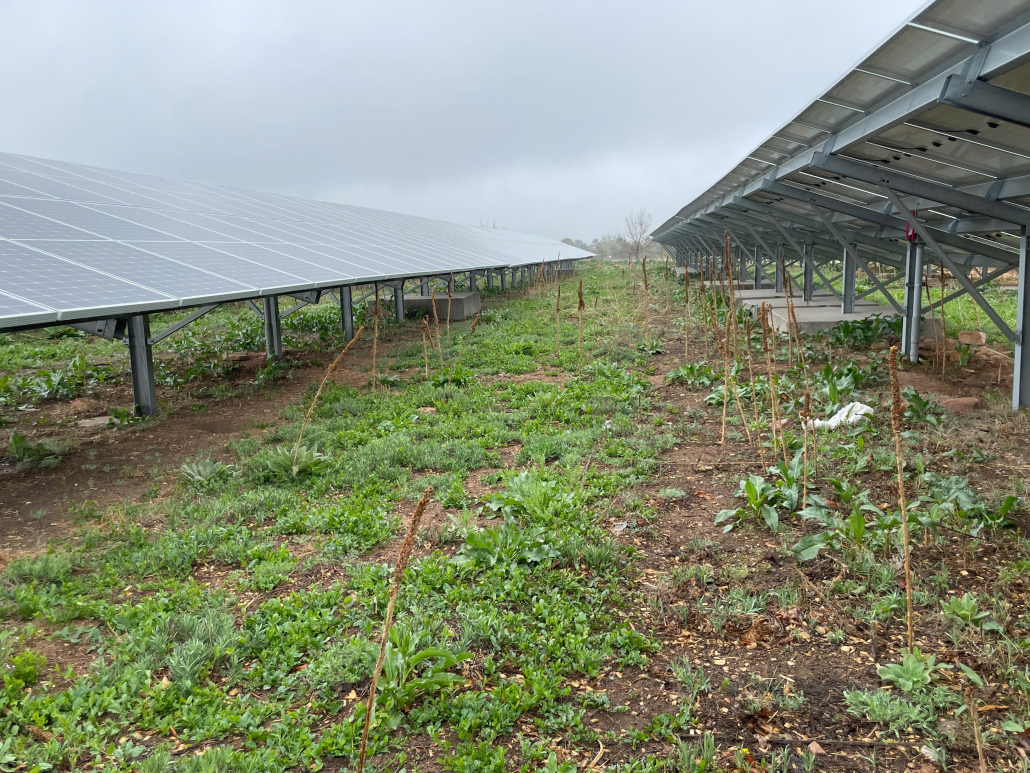
Area that has not been altered. Photo: Colorado Agrivoltaic Learning Center
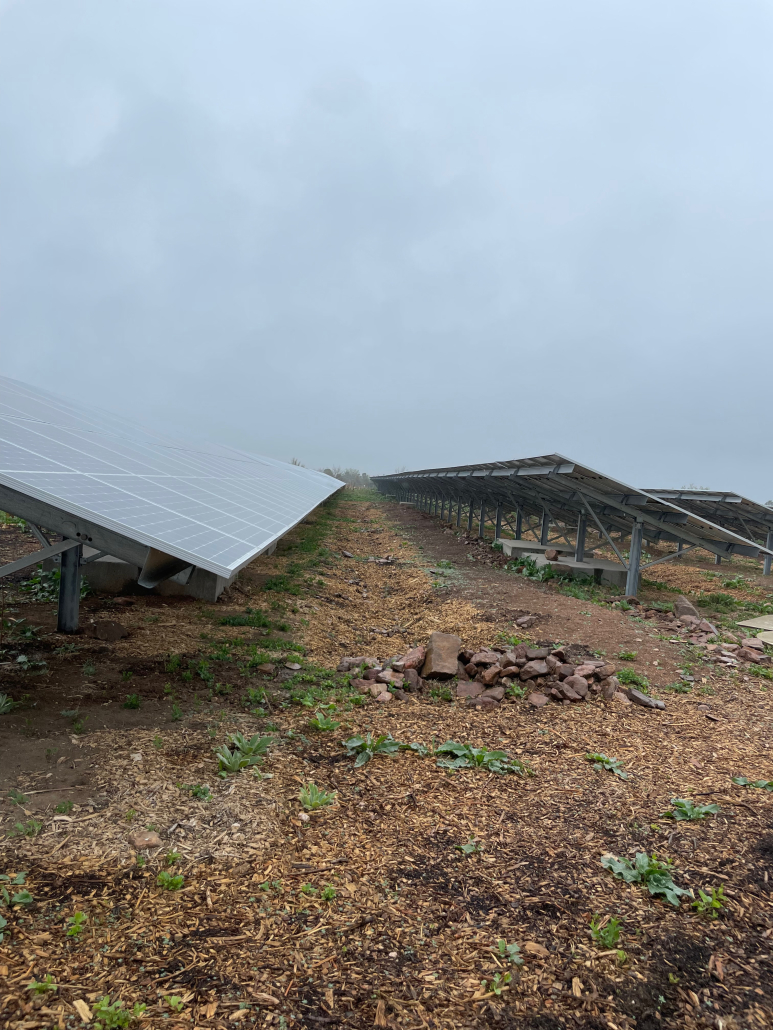
Area of the solar array with swales and perennial plantings. Photo: Colorado Agrivoltaic Learning Center
With no water source at this site, integrating agriculture into the semi-arid climate of Colorado is extremely difficult. So, in conjunction with the Drylands Agroecology Research, the landscape was altered utilizing permaculture ideas of slowing, spreading, and sinking rainfall to aid in water retention. A series of basins were dug and amended with compost at the leading edge of the solar panels to capture moist running off of the solar panels to sink the water deep within the soil’s profile. Having planted hundreds of hardy, drought-tolerant perennials, these basins will hopefully provide a repository of soil moisture for these plants during the driest months of the year. Utilizing the shade from the solar panels will also help slow evaporation from the soil and maintain a more even soil moisture.
The land was terraformed in November of 2022 with a mini-excavator and shovels. Perennial herbs were purchased and planted within the basins at the leading edge of the solar panels in April 2023. Irrigation was provided only at the time of planting for the perennials to get established. Herbs that were planted include fennel, lavender, lemon balm, oregano, rhubarb, thyme, and wild licorice. These plants will be monitored by researchers from the Dryland Agroecology Research group to assess their survivability and vigorousness.
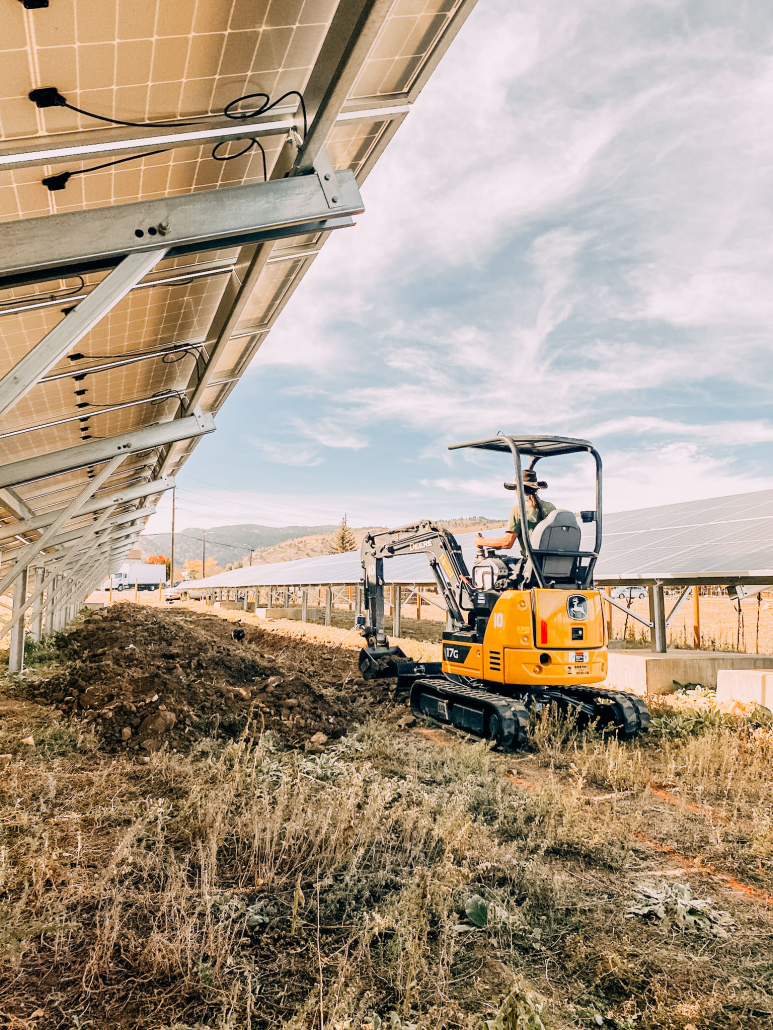
Terraforming the land in November of 2022 with a mini-excavator. Photo: Duncan Gilchrist, The Nature Conservancy
One benefit of having people within solar arrays stewarding the land is that they can catch system problems before the solar array asset owner does. Be it damaged panels, unsecured wires, or inverter errors, these issues can be easily monitored and relayed to the asset owner. In the long run, this can save asset owners money in operations and maintenance costs and potentially reduce the chances of lost revenues. During an initial site assessment for the viability of this agrivoltaics research project, consultants noted that the system’s inverters were offline followed by a discovery that the entire system was. The solar array asset owner was rapidly notified to alert their O&M team only to find out that the O&M company no longer serviced this site. The team also noticed that a small tree had grown up between two panels, shading their solar cells. These findings by the assessment team helped the solar array asset owner get their system back online, helped avoid future lost revenues, and kept their system running effectively.
With the wet spring and summer this year in Colorado, the perennials are growing and thriving. Hopefully, this project can be a model for retrofitting solar arrays and incorporating agriculture under the microclimates that solar panels provide.
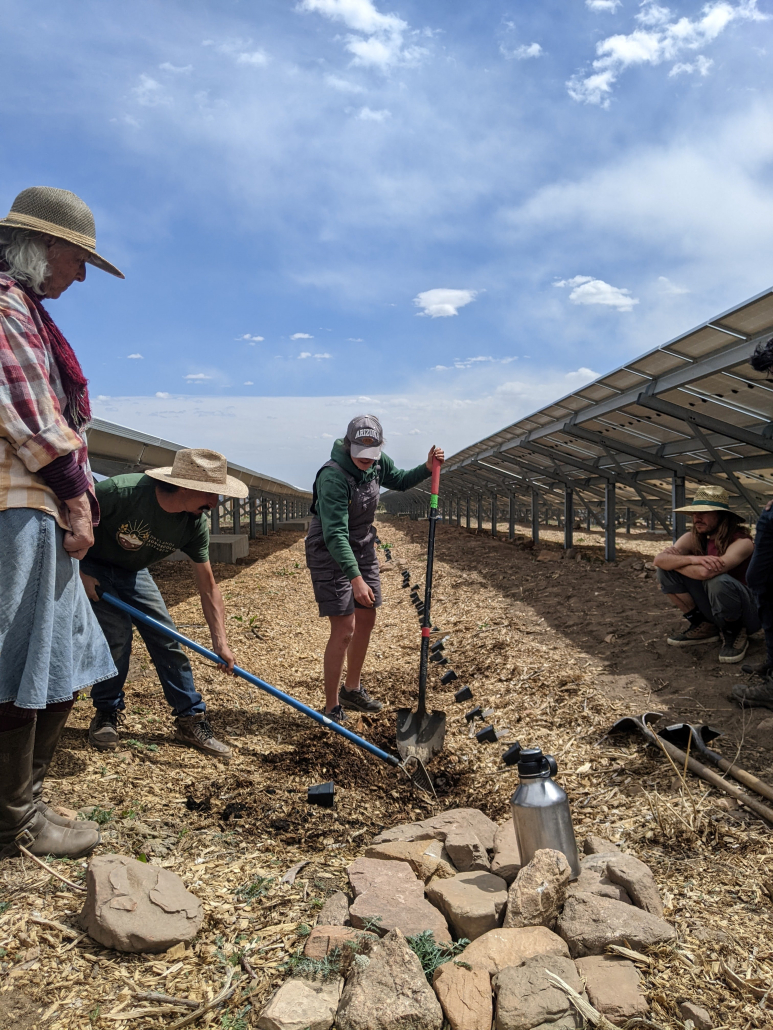
Planting perennial herbs within the basins. Photo: Duncan Gilchrist, The Nature Conservancy
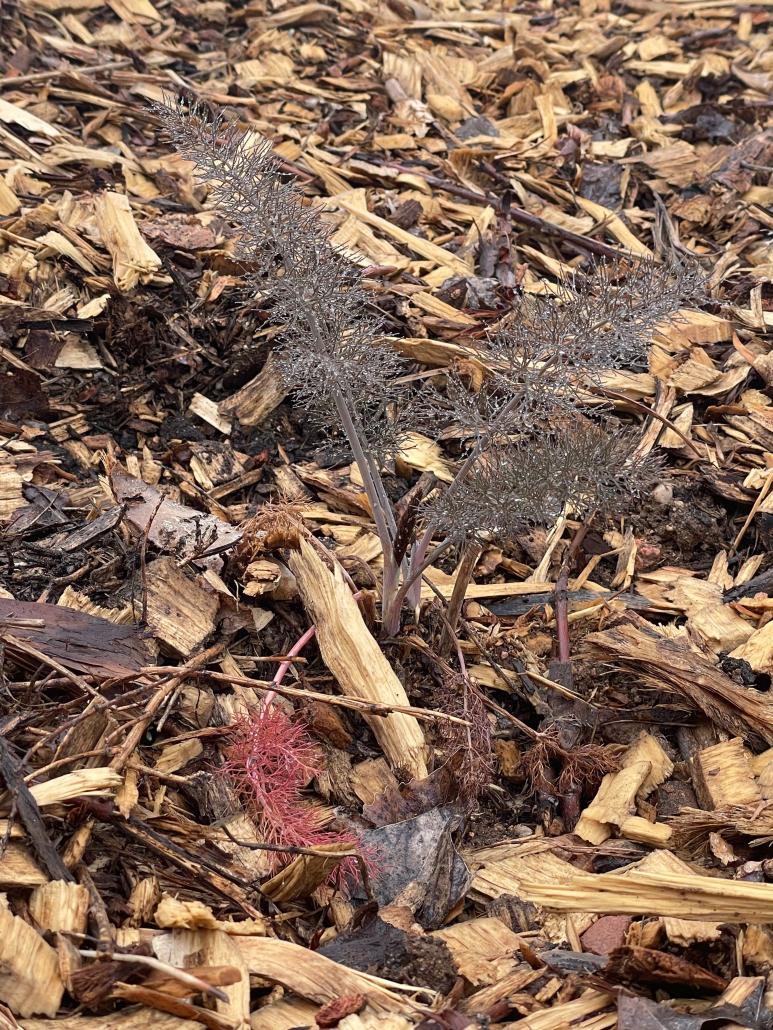
Bronze fennel plant thriving in the solar array. Photo: Colorado Agrivoltaic Learning Center
Written for the AgriSolar Clearinghouse by Ridge to Reefs staff Emma Verlinden, Paul Sturm, and Phal Mantha
In 2017, the devastation following Hurricane Maria was catastrophic for countless coastal communities. The archipelago of Puerto Rico experienced mass power loss and severe food-supply shortages, leaving many rural communities without power for extended periods of time (in some cases for as long as 6 to 12 months). Agricultural lands became unusable, with crop fields devastated by high winds, extreme rainfall, and incessant flooding. Following the catastrophe, the only seed producer in the archipelago lost nearly their entire supply due to a lack of refrigeration caused by the extended power outage. Meanwhile, shelves were empty at stores due to nearly 90% of Puerto Rico’s food being imported and food spoiling during the power outage.
In response to this challenge, Ridge to Reefs designed a Mobile Solar Walk-In Refrigeration System to help farms reduce post-harvest losses and bring high-quality produce and refrigerated farm goods to market. Additionally, Ridge to Reefs led and assisted in the construction of numerous stationary iterations of this design at various locations throughout Puerto Rico. The mobile system design is constructed around a 6’x14’ single-axle enclosed trailer, with six (280-watt) photovoltaic panels mounted on the rooftop. CoolBot technology is paired with a 10,000 BTU window air-conditioning unit, 2,000-watt Pure Sine Wave inverter, 210 amp-hours of batteries, and a charge controller to maintain temperatures between 40and 55°F per the farmers’ needs. The panels atop the trailer provide 1.68kW of power with ample battery storage, reducing the risk of crop loss in the event of a major power outage. The trailer is fully insulated (to above R-20) throughout the walls, roof, and floor, allowing for heat resistance in even tropical climates. In all, approximately 275 cubic feet of storage is available inside the unit to allow farmers to efficiently store and transport their agricultural goods. Because the power systems are grid-tied in Puerto Rico, and with such high risk of natural disaster occurrences, Ridge to Reefs designed this highly agile system to be grid-independent, using commercial, off-the-shelf technologies as dictated by community need.
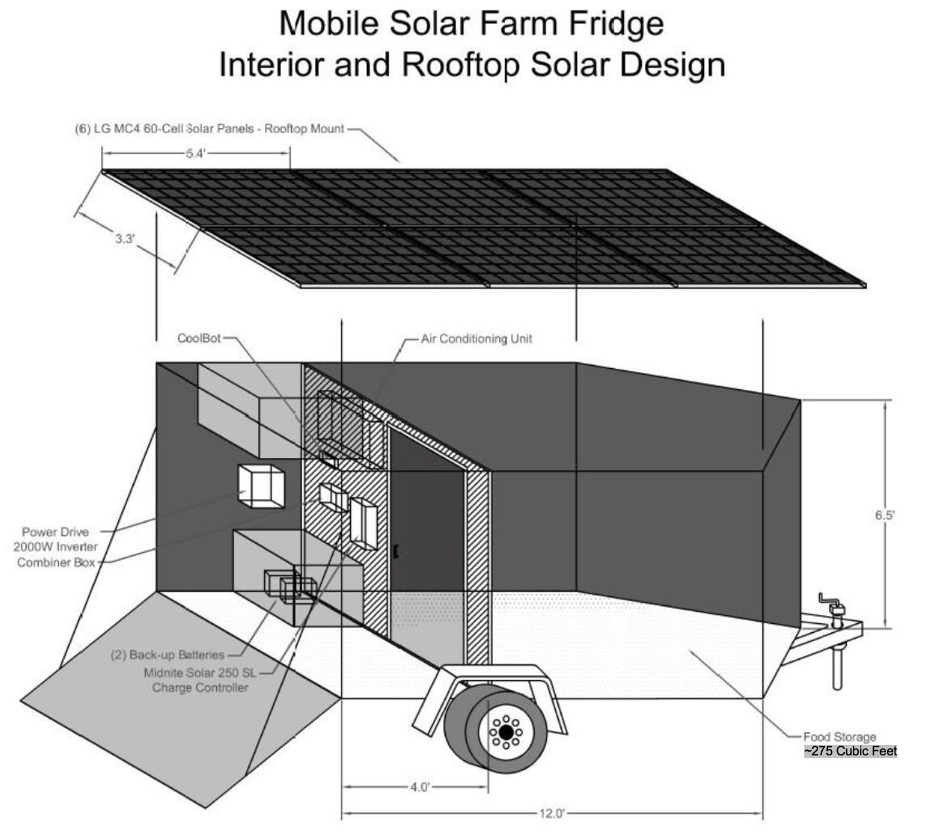
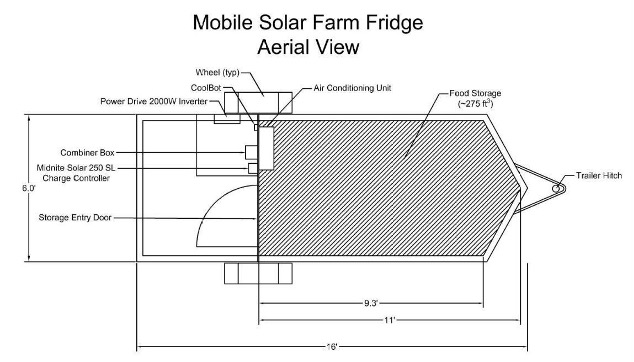
The construction and deployment of a mobile refrigeration system presents a viable solution for producers to more efficiently transport and store their goods throughout tropical regions, especially those that are susceptible to natural disasters. The entire system was constructed for approximately $10,000 USD, but potential grant and funding opportunities for farmers seeking to transition to solar operations could allow technology of this sort to become more available. Additionally, this option may allow island communities to cultivate greater market portions of locally sourced foods by increasing the sales reach of small-scale agricultural operations. Many producers do not have access to refrigerated shipping methods, and having on-site cold storage and transport for their goods can prove very economically stimulating.
Costs of electricity in island regions such as Puerto Rico and Hawai’i are on average four times higher than in mainland communities, which can prove detrimental to the capabilities of local farms in these regions. By providing farmers with the capacity to store and distribute their produce independently, they are able to reinvest the saved costs and increased profits into their own operations and increase overall productivity. In this way, the solar-powered refrigeration systems also promote local circular economies.
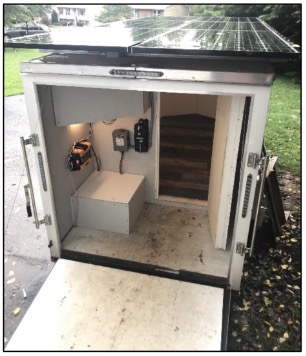
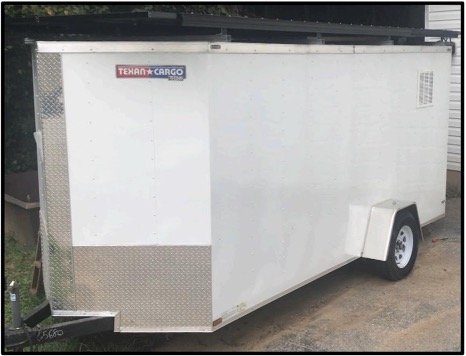
Completed construction of the mobile solar-powered refrigeration prototype that was donated by Ridge to Reefs.
The deployment of the mobile solar cold-storage system also taught our team and partners numerous valuable lessons. First, in mountainous regions, maneuvering a towed trailer system can be less than ideal and a task not every driver is comfortable with. It may be worth exploring integrating this sort of system into a “Sprinter” van or similar large van. Furthermore, the utilization of lithium iron phosphate or even lithium ion battery banks may offer significant advantages and may prove to be feasible improvements. With our system, an increase in battery bank capacity would have significantly improved standalone time and a battery bank capacity of closer to 300 or 350 amp-hours would have provided three to four days of standalone time. Additionally, with improvements in solar panel technology, many higher-output panels are available with the same dimensions. For example, 330-watt panels could be used for the next generation, allowing for higher power output. The Ridge to Reefs Team plans on first upgrading the existing mobile trailer with these improvements and is also seeking opportunities to construct and deploy similar systems in the future.
The implications of solar integration into agricultural operations are vastly important, especially considering the global call for an increase in the utilization of renewable energy sources. While this system is a small-scale mobile refrigeration unit, Ridge to Reefs has also constructed numerous other stationary solar refrigeration systems throughout Puerto Rico to ensure the security of crops for farmers during times of distress. Systems such as these could create opportunities for producers in other tropical regions such as Hawai’i by allowing them to reduce crop wastage, reach new markets, recirculate money in their community, and address concerns related to sustainability, food security, and developing local economies.
Photos courtesy of Ridge to Reefs
For more than 150 years Knowlton Family Farms in Grafton, Massachusetts has been a family-owned operation. It’s grown and shrunk over the years, and now is back in a period of expansion thanks to combining solar energy production with agriculture.
The National Center for Appropriate Technology’s (NCAT) AgriSolar Clearinghouse today released its short film “The Cows Come Home,” which shows viewers how the Knowlton family has been able to reintroduce cattle to their farm. Owner Paul Knowlton says the last of their dairy cows were sold in 1995, and now they’ve been able to bring cattle back to the farm to graze among solar panels.
“We really wanted to try to do something different, and we made it happen, it’s a reality, and I couldn’t be more pleased with the results,” Paul Knowlton said. “It was designed with the cows in mind, vegetables in mind, and also we can put a variety of different animals in here for grazing. They [the cows] took to it like fish to water.”
AgriSolar or agrivoltaic partnerships are growing across solar-appropriate farmland in the U.S., providing a new revenue source for farmers, clean energy for surrounding communities, and myriad benefits to crops, livestock, and pollinators.
Knowlton says agrisolar is what has allowed his farm to remain a viable family business.
“Nationwide, this could be a new standard,” Knowlton adds. “The idea of year-round revenue is really, really important. Having a farm that has the ability to survive is just so important. This is a way to keep the farmland going.”
NCAT’s AgriSolar Clearinghouse is connecting businesses, land managers, and researchers with trusted resources to support the growth of co-located solar and sustainable agriculture.
“AgriSolar partnerships are helping to keep family farms in family hands,” said NCAT Energy Director Stacie Peterson, PhD. “We can maximize finite resources for the benefit of communities, the environment, and businesses when agriculture and energy come together.”
